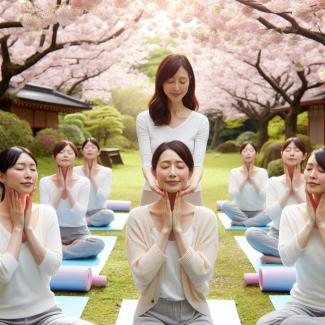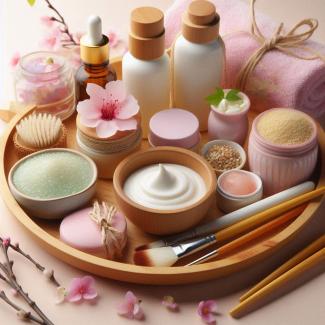
Japanese Facial Yoga is a practice that goes beyond traditional skincare routines by engaging the muscles of the face to improve tone, lift, and overall skin health. Unlike cosmetic surgeries or invasive procedures, facial yoga is a natural, non-invasive way to reduce wrinkles, improve circulation, and enhance the facial structure over time. Rooted in ancient beauty traditions, Japanese facial yoga focuses on stimulating blood flow, boosting collagen production, and toning muscles to create a youthful, radiant complexion.
This comprehensive guide will explore the basic exercises involved in Japanese facial yoga, the benefits you can expect from regular practice, and recommendations to help you incorporate this practice into your daily life.
Table of Contents
- Introduction to Japanese Facial Yoga
- Basic Facial Yoga Exercises
2.1. Warm-Up Routine
2.2. Forehead Smoother
2.3. Eye Brightener
2.4. Cheek Lifter
2.5. Jawline Sculptor
2.6. Neck and Chin Tightener - Benefits of Japanese Facial Yoga
3.1. Anti-Aging and Wrinkle Reduction
3.2. Enhanced Skin Elasticity and Collagen Production
3.3. Improved Circulation and Lymphatic Drainage
3.4. Reduction of Puffiness and Dark Circles
3.5. Enhanced Facial Symmetry
3.6. Stress Relief and Relaxation - Recommendations for Practicing Japanese Facial Yoga
4.1. Frequency and Duration of Practice
4.2. Best Time to Practice
4.3. Posture and Breathing Techniques
4.4. Combining Facial Yoga with Skincare
4.5. Common Mistakes to Avoid - Conclusion
1. Introduction to Japanese Facial Yoga
Japanese facial yoga, or "face yoga," is a technique that combines facial exercises, massages, and poses to improve the overall appearance of the skin. By targeting specific muscles, facial yoga can prevent or minimize the signs of aging, improve circulation, and promote relaxation. Unlike facial creams or treatments that work on the surface, facial yoga works from within, utilizing the muscles of the face to tighten, lift, and firm.
A unique aspect of Japanese facial yoga is its holistic nature. Not only does it help improve the physical structure of the face, but it also has mental and emotional benefits by reducing stress and tension, which are often carried in the muscles of the face. Regular practice of facial yoga can result in a healthier, more youthful appearance without the need for costly or invasive treatments.
2. Basic Facial Yoga Exercises
Japanese facial yoga involves a series of simple, targeted exercises that are designed to engage and strengthen the muscles in different parts of the face. These exercises, when done consistently, can yield significant improvements in facial tone, skin elasticity, and overall appearance.
2.1. Warm-Up Routine
Just like any other form of exercise, it’s important to warm up the muscles before starting facial yoga. Warming up helps increase blood circulation and prepares the muscles for deeper engagement.
Instructions:
- Gently massage your face with your fingertips, starting from the center and moving outward in circular motions.
- Apply light pressure around the forehead, cheeks, and jawline.
- Massage for about 1-2 minutes to stimulate blood flow and loosen up the muscles.
2.2. Forehead Smoother
The forehead smoother is designed to reduce horizontal wrinkles on the forehead by strengthening the frontalis muscle. This exercise can also help prevent sagging in the brow area.
Instructions:
- Place both hands on your forehead with your fingers spread wide.
- Gently press down while trying to raise your eyebrows.
- Hold the resistance for 10 seconds, then release.
- Repeat this exercise 5-10 times.
This exercise helps lift the forehead and reduces the appearance of deep wrinkles.
2.3. Eye Brightener
This exercise targets the muscles around the eyes, helping to reduce puffiness, dark circles, and crow’s feet. Strengthening the eye muscles can also give the eyes a more open and refreshed look.
Instructions:
- Place your index fingers just below your eyebrows and gently lift the skin.
- Look up and squint your lower eyelids, creating a squinting motion.
- Hold for 5-10 seconds, then relax.
- Repeat 5 times.
The eye brightener exercise is excellent for reducing signs of tiredness and making the eyes appear larger and more awake.
2.4. Cheek Lifter
The cheek lifter targets the muscles in the mid-face to help lift and tone the cheeks, preventing sagging and reducing the appearance of smile lines.
Instructions:
- Sit up straight and smile as wide as possible, keeping your lips closed.
- Place your fingers on your cheeks and gently lift the skin upward while holding the smile.
- Hold this position for 10 seconds, then release.
- Repeat 10 times.
Regular practice of the cheek lifter can give the face a more youthful and lifted appearance.
2.5. Jawline Sculptor
The jawline sculptor is designed to tone the muscles along the jawline and neck, helping to reduce the appearance of a double chin and create a more defined jawline.
Instructions:
- Sit or stand with your back straight and tilt your head back to look at the ceiling.
- While in this position, move your lower lip over your upper lip as if trying to stretch your chin upwards.
- Hold for 5-10 seconds, then relax.
- Repeat 10 times.
This exercise strengthens the muscles under the chin and along the jawline, creating a more defined and sculpted appearance.
2.6. Neck and Chin Tightener
This exercise focuses on the neck muscles, helping to reduce sagging skin and improve the appearance of the jaw and neck area.
Instructions:
- Sit with your back straight and shoulders relaxed.
- Tilt your head back to look at the ceiling and press your tongue against the roof of your mouth.
- Hold for 10 seconds, then relax.
- Repeat 10 times.
The neck and chin tightener helps prevent sagging in the neck area and improves the definition of the jawline.
3. Benefits of Japanese Facial Yoga
The benefits of Japanese facial yoga extend beyond just aesthetics. By regularly practicing these exercises, you can see improvements in both the appearance of your skin and your overall well-being.
3.1. Anti-Aging and Wrinkle Reduction
One of the most prominent benefits of Japanese facial yoga is its ability to reduce the signs of aging, such as fine lines and wrinkles. By strengthening the facial muscles, these exercises help smooth out the skin, reducing the appearance of wrinkles around the eyes, forehead, and mouth.
3.2. Enhanced Skin Elasticity and Collagen Production
Facial yoga stimulates collagen production, which is essential for maintaining skin elasticity and firmness. As you age, collagen production naturally decreases, leading to sagging skin and wrinkles. By engaging the facial muscles, facial yoga encourages the body to produce more collagen, helping to keep the skin firm and youthful.
3.3. Improved Circulation and Lymphatic Drainage
The movements involved in facial yoga help stimulate blood circulation, delivering oxygen and nutrients to the skin cells. This improved circulation promotes a healthy, glowing complexion. Additionally, facial yoga helps stimulate the lymphatic system, which is responsible for removing toxins and excess fluid from the body. This can reduce puffiness, particularly around the eyes and cheeks.
3.4. Reduction of Puffiness and Dark Circles
By improving circulation and lymphatic drainage, facial yoga can help reduce puffiness and dark circles under the eyes. These exercises encourage the removal of excess fluid that can accumulate under the eyes, giving the face a more refreshed and revitalized appearance.
3.5. Enhanced Facial Symmetry
Many people have asymmetrical facial features due to uneven muscle use. Facial yoga works to engage all the muscles of the face equally, helping to balance the tone and improve overall facial symmetry. Over time, this can result in a more balanced and harmonious appearance.
3.6. Stress Relief and Relaxation
Stress often manifests physically in the face, leading to tension in the jaw, forehead, and around the eyes. Facial yoga encourages relaxation by relieving this tension, which can reduce the appearance of stress-related wrinkles and improve overall facial expression.
4. Recommendations for Practicing Japanese Facial Yoga
For optimal results, it’s important to practice Japanese facial yoga consistently and correctly. Below are some tips to help you get the most out of your practice.
4.1. Frequency and Duration of Practice
For best results, it’s recommended to practice facial yoga for at least 15-20 minutes a day, five to six days a week. Like any exercise, consistency is key to seeing long-term improvements in muscle tone and skin health.
4.2. Best Time to Practice
Facial yoga can be practiced at any time of the day, but many people find it most beneficial in the morning as it helps wake up the face and improve circulation. Practicing before bed can also be a great way to relax and release tension from the day.
4.3. Posture and Breathing Techniques
Proper posture is important during facial yoga exercises to avoid straining the neck or back. Sit or stand with your back straight, shoulders relaxed, and neck aligned with your spine. Focus on taking deep, controlled breaths during the exercises to help promote relaxation and oxygenate the skin.
4.4. Combining Facial Yoga with Skincare
For enhanced results, combine facial yoga with your skincare routine. Applying a light facial oil or serum before practicing can help improve the glide of your fingers across your skin and enhance the absorption of skincare products.
4.5. Common Mistakes to Avoid
One common mistake people make when practicing facial yoga is overworking the muscles. While it’s important to challenge the muscles, overdoing it can lead to tension and strain. Be mindful of how your face feels during the exercises and avoid forcing any movements that cause discomfort.
Japanese facial yoga offers a natural, non-invasive way to improve facial tone, reduce the signs of aging, and enhance overall skin health. By regularly practicing the basic exercises outlined in this guide, you can achieve a more youthful, lifted appearance without the need for costly or invasive procedures. Additionally, facial yoga provides the added benefit of stress relief and relaxation, making it a holistic approach to beauty and wellness.
Incorporating facial yoga into your daily routine is simple and accessible, requiring only a few minutes of practice each day. Whether you’re looking to reduce wrinkles, improve skin elasticity, or simply give your face a more refreshed look, Japanese facial yoga is an effective and rewarding practice to adopt.






